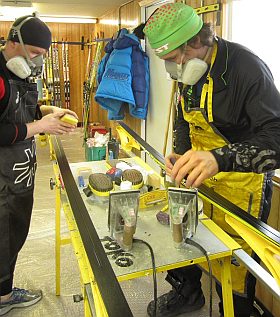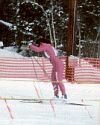Minnesota High School Nordic Ski Coaches Association Fall Meeting Recap
October 29, 2016The annual Minnesota High School Nordic Ski Coaches Association Fall Meeting at the Vasaloppet Center in Mora, MN, drew over 60 coaches from across the state to discuss a number of issues, including a new State Meet proposal and new waxing policy.

New State Meet Proposal
As outlined previously, the new State Meet proposal would bring sprinting into the high school competition, incorporating it at sections and the State Meet. A team sprint format would be used, where teams of two skiers from each school would ski four laps (roughly 1K laps), with skiers alternating between laps and utilizing an exchange zone (instead of tagging off). The traditional pursuit race would also be held, but with a maximum of five skiers from each team (previously seven). The advancement from sections to the State Meet would be based on the combined team scoring of the pursuit format race and the team sprint competition, with each skier have an equal weighted score (top three from pursuit, two from team sprint). The top two teams based on the combined score would advance to the State Meet (five from the pursuit race, two from the team sprint), along with the fastest team sprint and fastest four pursuit skiers, which are not part of the two advancing teams.
Proponents of the proposal emphasized the role of sprinting in the current national and international competitions, and the popularity amongst high school skiers as well as spectators. It was stated that other states have already incorporated sprints into their high school racing, and Junior National competition has been featuring sprint events for many years now. A number of coaches felt the roughly 1K distance sprints would dovetail well into the normal 5K race distance for training.
Numerous concerns were raised with the current proposal. Chief among the concerns was the impact it might have on teams, possibly causing some skiers to specialize in sprinting and the need for additional coaching staff, and how that may lead to a reduction in team unity (many coaches compared the change to track and field). There was also concern over the additional logistics and complexity in implementing team sprints, especially for implementing at conference races. It was also pointed out that any skiers competing in sections, would have to compete in the same discipline at the State Meet (including alternates), so if an athlete was unable to compete due to injury or illness, it may be possible the school would not be able to field a team sprint combo.

The proposal also includes a new two day State Meet format. The existing Charlie Banks Relay on Wednesday would be moved up to an earlier time (and changed to a mixed gender relay), with the first half of the pursuit race held in the afternoon. The second day (Thursday) would start with the team sprint semifinals, followed by the second half of the pursuit race, and then would conclude with the team sprint finals.
There were several arguments in favor of the two day format, including an easier waxing schedule for the pursuit race, as well as more rest for the pursuit skiers. Concerns raised included the extra time away from school as well as possible conflict with the alpine meet (held on Wednesday) if teams attempted to come up on Tuesday night.
The planned vote on the new proposal was delayed after it was discovered the scoring system was weighted more heavily on the pursuit event than the proposed 62% / 38% division. Coaches were working on updates to correct the scoring, and hoped to release a revised proposal in the coming week with online voting to follow. If the proposal was to pass, it would not be implemented until the 2017-18 season at the earliest, and would still require approval from the Minnesota High School League.
Waxing Policy
 Following a growing trend in junior competition, a policy of reducing the impact of fluorinated waxes was discussed. The general policy will be to ban the use of powder fluoros in all competitions, and leave the decision to allow fluorinated waxes and blocks/liquids in conference races and sections to be decided by the conference/section coaches. The issue of enforcement was a key concern, as there is no simple way to detect fluoro usage. However, the positive impacts of reduced costs and health impacts along with a more level playing field led to an overwhelming passage of the proposal, which will go into effect this season.
Following a growing trend in junior competition, a policy of reducing the impact of fluorinated waxes was discussed. The general policy will be to ban the use of powder fluoros in all competitions, and leave the decision to allow fluorinated waxes and blocks/liquids in conference races and sections to be decided by the conference/section coaches. The issue of enforcement was a key concern, as there is no simple way to detect fluoro usage. However, the positive impacts of reduced costs and health impacts along with a more level playing field led to an overwhelming passage of the proposal, which will go into effect this season.
Round Table Recap
Two weeks ago, a round table discussion was held in Eden Prairie on a number of topics related to high school skiing. Primary among those topics was the usual discussion on the conflicts between Nordic clubs and high school teams. Top aspects included a discussion on which body should have authority for waxing the athletes’ skis, as well as athletes substituting some of their official high school workouts with club workouts. It was pointed out that according to Minnesota High School League rules (bylaw 208, subsection 1.A.3a), it is a violation for athletes to skip their high school workouts in favor of a club workout. [ It should be noted that bylaw 208 also implies athletes can not race in competitions that match their high school race formats, nor can high school skiers wear their school uniforms when competing in non-high school races. ] In the end, it was emphasized both clubs and high school coaches need to work together to reduce skiers from being stuck in the middle.
Additional Topics
A presentation was given on the inclusion of adaptive athletes into high school races. There is a scoring system in place that allows adaptive skiers to have their times adjusted such that they can be included in regular high school events. Coaches were encouraged to work within their districts to hopefully incorporate more adaptive athletes.
The possibility of drone footage from the State Meet is being researched. A number of issues are still be investigated, including how that footage would be made available, what events would be covered, and where the drones might be able to fly.
The passing of Osseo coach Brad Rosch a few weeks ago was recognized at the start of the conference with a moment of silence. There was also a proposal to have a memorial bench for Rosch installed at Elm Creek, with the coaches association donating $500 toward this goal. The proposal passed unanimously.
Ski pole length, especially in classic races, is the latest hot button topic in the Nordic world. A brief discussion was held with the consensus being the group would observe how the new FIS rules impact the sport this season.
The new agreement between the Loppet Foundation and the Minneapolis Park Board and its impacts on the skiing at Theodore Wirth was presented. The Loppet Foundation plans to offer reduced student pricing on ski passes early season, and will not implement a limit on the teams practicing at Wirth (but teams needing a specific practice space will have pay for a separate area). High school races will also be allowed at Wirth with exclusive access to a portion of the snowmaking loop (the remainder will be open to regular skiing). A few improvements were announced as well, including some trail rerouting (in part for the new Trailhead building), and eventual construction of a cooling tower for snowmaking.

The morning session concluded with award recognitions, including Volunteer of the Year (Jay Richards, Maplelag Resort), Assistant Coach of the Year (Leon Zeug, Chaska/Chanhassen) and Coach of the Year (Cheri Johnson, Mesabi East). The Hall of Fame inductees were also recognized, which included Glen Sorenson (C-E-C), Dave Johnson (Marshall School), as well as a second induction for Robert Klungness (Bloomington Jefferson).

